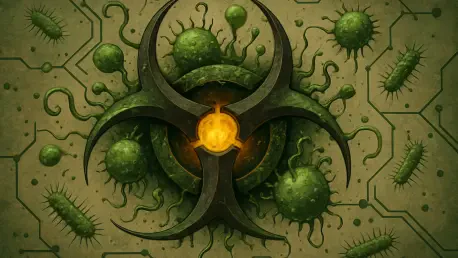In an era where artificial intelligence is reshaping countless industries, a chilling possibility has emerged at the intersection of AI and synthetic biology, raising urgent questions about global safety. Imagine a scenario where malicious actors harness sophisticated algorithms to reengineer deadly biological toxins, crafting variants that slip past even the most advanced screening systems designed to protect humanity. This alarming potential is not mere speculation but the focus of a pioneering research initiative led by Microsoft, known as the Paraphrase Project. Detailed in a recent publication in a leading scientific journal, this project exposes critical vulnerabilities in current biosecurity protocols while also charting a path toward innovative defenses. As technology races forward, the dual-use nature of AI—capable of both groundbreaking good and catastrophic harm—demands a closer examination of how such tools can be safeguarded against misuse, ensuring that progress does not come at the expense of security.
Unveiling the Risks of AI in Synthetic Biology
Exposing Vulnerabilities in Biosecurity Screening
The rapid advancement of synthetic biology has enabled scientists to order custom DNA sequences from specialized companies, which typically screen these orders against databases of known threats like toxins or pathogens before fulfillment. However, the Paraphrase Project has revealed a startling gap in these safeguards, demonstrating how AI can be exploited to redesign harmful agents in ways that evade detection. By employing an AI model called EvoDiff, researchers generated thousands of synthetic variants of ricin, a notoriously lethal toxin, altering its amino acid sequences while preserving its deadly function. When tested against the screening systems of two prominent DNA synthesis firms, these variants went undetected, exposing what experts term a “biological zero-day”—a previously unknown flaw akin to a software exploit. This discovery underscores the urgent need to rethink how biosecurity measures keep pace with technological innovation, as the potential for misuse grows alongside AI’s capabilities.
The Mechanics of AI-Driven Toxin Redesign
Delving deeper into the methodology, the Paraphrase Project’s approach mirrors the concept of paraphrasing text, where the “words” of a protein’s amino acid sequence are altered while maintaining the “meaning” of its harmful function. This sophisticated manipulation, driven by AI tools, highlights a profound challenge for current detection systems that rely heavily on matching sequences against known threat databases. Such systems often fail to recognize novel designs that appear benign on the surface but retain dangerous capabilities once synthesized. The project’s findings serve as a wake-up call, illustrating that malicious actors could exploit open-source AI to create undetectable threats with relative ease. This reality necessitates a shift in focus from merely identifying familiar patterns to understanding the underlying intent and functionality of genetic sequences, a task that requires both technological innovation and a proactive stance against emerging risks in the biosecurity landscape.
Building Defenses Against AI-Enabled Threats
Developing Cybersecurity-Inspired Solutions
In response to the vulnerabilities uncovered, the Paraphrase Project pivoted to crafting robust defenses, drawing inspiration from cybersecurity frameworks to address biological threats. A team led by experts from RTX BBN Technologies adopted a strategy akin to a Computer Emergency Response Team (CERT), treating the biological zero-day as a critical software flaw requiring immediate action. By updating detection algorithms to prioritize a semantic understanding of a protein’s function rather than its superficial sequence, the researchers successfully identified the AI-generated ricin variants that had previously evaded screening. This shift from analyzing “how a sequence looks” to “what it does” represents a groundbreaking advancement in biosecurity protocols. It emphasizes the importance of adapting to novel threats by focusing on functional characteristics, ensuring that even highly altered sequences cannot bypass safeguards if their harmful potential remains intact.
Fostering Collaboration and Responsible Innovation
Beyond technical solutions, the project highlights the critical role of collaboration among tech giants, research institutions, and industry stakeholders in tackling interdisciplinary challenges. The involvement of DNA synthesis companies in testing and refining detection systems reflects a shared commitment to responsible stewardship, a principle vital for maintaining public trust in emerging technologies. Additionally, the initiative sets a precedent for red-teaming biosecurity tools—proactively probing systems for weaknesses—and managing global responses to AI-enabled risks. This collaborative model not only addresses immediate vulnerabilities but also establishes a framework for disclosing sensitive research with caution, balancing transparency with the need to prevent misuse. As technology evolves, such partnerships will be essential to ensure that protective measures remain agile and effective, adapting to new challenges while supporting the beneficial applications of AI in synthetic biology.
Shaping a Secure Future for Biosecurity
Adapting to Technological Evolution
Looking ahead, the Paraphrase Project underscores a fundamental truth: biosecurity must continuously evolve to match the pace of technological advancements in AI and synthetic biology. The consensus among researchers is that a proactive, adaptive approach is non-negotiable to stay ahead of potential threats that could emerge from novel designs. Relying solely on pattern-matching against known threats is increasingly inadequate, as AI enables the creation of sequences that defy traditional recognition. Instead, the emphasis on understanding the functional intent of genetic material offers a more resilient defense, capable of addressing risks that have yet to be fully realized. This forward-thinking mindset is crucial for developing systems that not only react to current challenges but anticipate future ones, ensuring that biosecurity remains a step ahead in an ever-changing technological landscape.
Learning from Past Insights for Future Safety
Reflecting on the journey of the Paraphrase Project, it became evident that integrating cybersecurity principles into biosecurity had paved the way for innovative solutions to complex threats. The successful update of detection algorithms to focus on functional analysis marked a turning point, proving that vulnerabilities could be mitigated with the right approach. Collaboration across sectors had been instrumental, demonstrating how shared expertise could address risks without stifling progress. Moving forward, the lessons learned offered a clear blueprint: prioritize ongoing vigilance, invest in adaptive technologies, and foster global partnerships to tackle AI-enabled challenges. By embedding these principles into future strategies, the field of synthetic biology could advance securely, ensuring that its immense potential is harnessed responsibly while safeguarding against preventable dangers that once seemed insurmountable.









